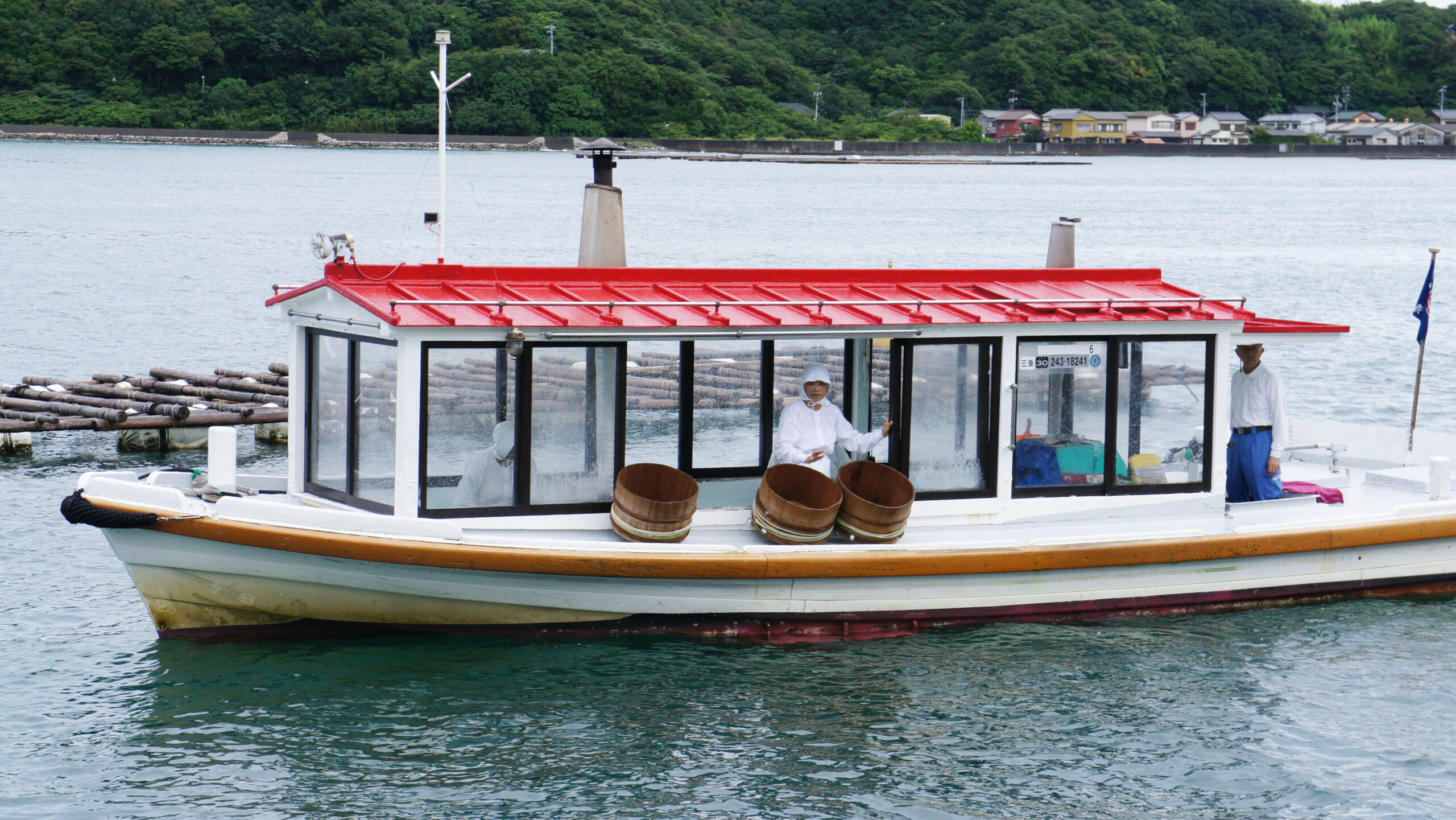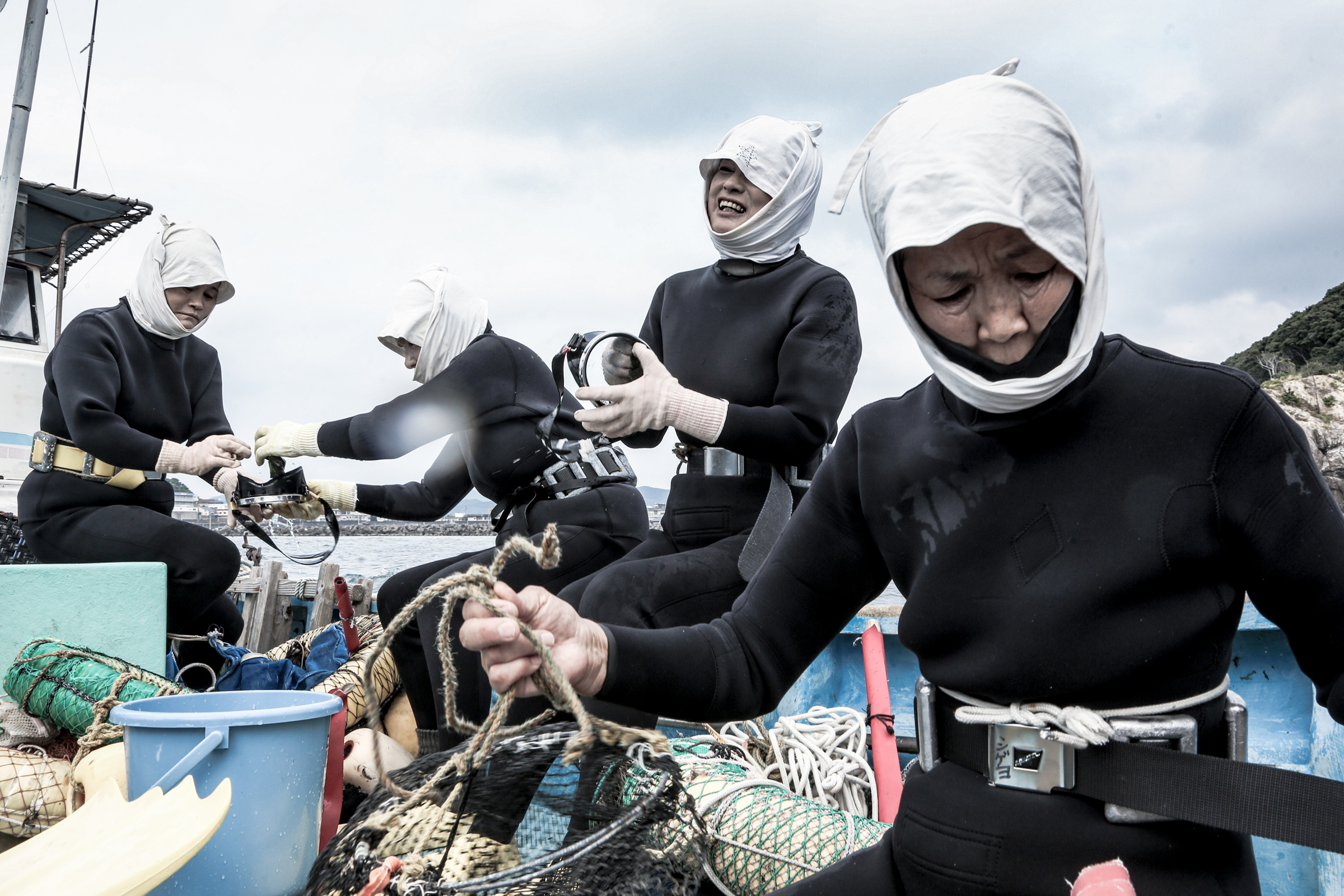In this town, you may often see women in the sea. From the edge of a boat, they’ll toss themselves confidently into the ocean, while others wade in from the shore. But these are no casual bathers. Armed with a rustic-looking face mask and a net suspended from a homemade float bobbing on the water, one woman dips below the surface, disappearing into the depths below. A moment later, a hand emerges first, holding up its prize: an abalone plucked from the sea floor.

These are the Japanese pearl divers, or Ama of Toba, Japan. An all-female profession, they free dive without the special equipment that accompanies most divers nowadays—no air tank, and until about the 1970s, without even wet suits to shield them from the cold ocean waters in which they dive year-round.
The Ama divers have a history that stretches back several thousand years, with mentions of them appearing even in historic texts like the Manyoshu, a 6th century poetry collection. At their peak, there were some 6,000 Ama divers here in the Ise-Shima area, where Toba is located, but today they number less than six hundred—the highest population of these divers in Japan.

Still, with a visit to this seaside town just 20 minutes from the famous Ise Grand Shrine, Ise Jingu, visitors can still catch a glimpse of this vanishing way of life up close, whether through exhibits at some of Toba’s remarkable maritime museums, through spots sacred to the divers, or in-person with a lunch served fresh by an Ama herself!
(See below for tours and experiences to book!)
Dive into Tradition: Witnessing the Ama’s Artistry at Mikimoto Pearl Island

Upon arriving in Toba, an introduction to the Ama divers awaits at Mikimoto Pearl Island, a short stroll from Toba Station. Near the water’s edge is where you can witness Ama divers showcasing their traditional diving techniques, jumping from a small boat just offshore. The waters here are a bit shallower at about three meters—Ama dives at sea can reach depths of 20 meters and lengths of 50 seconds utilizing a specialized breathing technique called isobue—but demonstrations are held multiple times a day, and it’s a great way to see the Ama’s skill at free diving up close. Guests who make advance reservations can see the diving from a private room with a foreign language explanation.
When you step onto the island, you’ll be greeted by a towering statue of Kokichi Mikimoto, founder of the cultured pearl industry and a Toba native. This statue, a testament to his pioneering spirit, was financed by the local people of Toba. The island’s museum offers intricate displays on pearl production and oyster cultivation, along with a splendid collection of antique pearl jewelry, and an official Mikimoto jewelry store.



Exploring Ama Heritage: Treasures of the Toba Sea-Folk Museum


For a deeper dive into the history of the Ama, head to the Toba Sea-Folk Museum, located in a cluster of unique buildings designed by architect Naito Hiroshi. This museum is a real treat, with over 60,000 pieces in its collection, including the tools of the Ama, 90 wooden boats collected from across Japan, and a wide array of interactive exhibits with which guests can learn more about the Ama, their craft, and connection with the sea, from the unusual grid and star symbols the Ama use to adorn their clothes to ward off evil spirits beneath the waves, to the abalone offerings they’ve long provided to Ise Grand Shrine, Ise Jingu.
Immerse Yourself in the Culture of the Ama on the Osatsu Peninsula
But what really makes Toba special is the ability to interact with these living cultural wonders. To really get off-the-beaten path and into the world of the Ama, you’ll want to head to Toba’s Osatsu area.


You’ll recognize the location for its cluster of small shops, like Ama House “Gozaya,” a charming gift shop with a café attached, and Osatsu Kitchen 0032, a café stand offering local drinks and sandwiches made with locally-caught fried fish. These shops line the path up to Shinmei Shrine, and its smaller neighbor, a shrine known locally as Ishigami-san. The shrine is often visited by Ama praying for a rich catch and safe diving, but it’s also a popular shrine for female visitors, as legend has it that it will grant each woman one wish… is there something you’d wish for?

Back towards the coast, shielded from the sun and the ocean breezes in a small seaside hut nestled against the rocky cliffs, Chizuko Nakamura, age 71, is busy preparing a lunch of fresh horse mackerel, clams, turban shell, and squid with rice and miso soup. These huts were traditionally used as a place of rest for the Ama after their dives, but now, in huts like Osatsu Kamado, visitors can book a seafood lunch served by the Ama themselves.


Born into a family of Ama, Ms. Nakamura grew up playing in the waves in which she still dives today. “In my day,” she explains, turning over the ocean feast on the coals with a pair of tongs, “the only entertainment we had was to play in the sea. By the end of primary school, we joined our mothers in the ocean to catch abalone.” Oysters can be farmed from rafts hanging in the swells, but abalone can only be retrieved by the Ama’s skill, although recent efforts have been made to avoid overfishing the delicacies.


“As kids, we would go out swimming on our own. When children were older, those in Ama families might be late for school, because they were out diving at 5 in the morning.” Ms. Nakamura’s mother’s generation dove both morning and afternoon, and even Ms. Nakamura herself barely let childbirth get in the way of her dives: “Even when very pregnant, we still dive right up to the end,” she says, laughing. “Once they’re born, it’s back to the sea again!”
Serving steaming plates of rich seafood, she explains that a changing climate and a falling population of Ama has meant far fewer dives. The Ama are careful about which seafood they retrieve so as not to overfish, and yet changing seas have depleted populations of once plentiful seaweeds like hijiki, making for smaller catches.

Though the future of these highly-skilled divers’ culture is unknown, Ms. Nakamura is encouraging, waving off her visitors at the entrance of her hut by the sea “I want people to visit, and carry on the work of the Ama,” she says. Honed and passed down over thousands of years, the skills of the Ama are an extraordinary living cultural heritage, and in their home here in Toba, there’s a remarkable chance to immerse yourself in their ancient way of life.
Book a tour or experience to explore locations in this article and delve into the world of the Ama:



